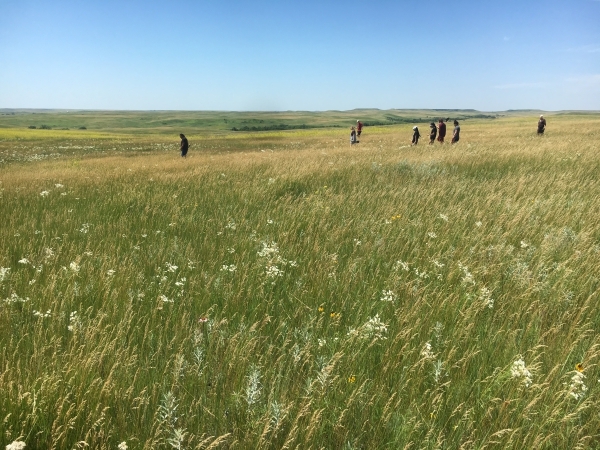BRATTLEBORO — On my drive to meet up with the Brattleboro Area Interfaith Youth Group, I stopped when I reached the Missouri River, the eastern boundary of the Cheyenne River Reservation. I pulled into a park to picnic and gather myself for the big unknown week ahead.
I had a professor in college who would say, “You see what you know.” That evening I saw a beautiful expanse of water reflecting the sunset with the greens and yellows of the prairie hills rising up from the shores.
I had about 30 more minutes to drive to get to the Simply Smiles community center in LaPlant, South Dakota, so, after I finished my sandwich, I pulled myself from the calming scene and got back in the car. As I neared the bridge to cross the river, I saw a sign for Forest City. The name struck me, because neither word described the few buildings and prairie I saw around me.
I hadn't realized that I was technically crossing over Lake Oahe, a reservoir created by a dam. Much like the Connecticut River here is essentially a series of lakes due to dams, so it is in that part of the Missouri River.
I later learned about the impact of the dam from Madonna Thunder Hawk, a Lakota elder whose lifelong work has been for Native American rights and cultural vitality. The land now underwater had been the Reservation's best foraging and farming soils and had been critical to the food sovereignty of the Lakota people.
Before the trip, I had the impression that the violence and oppression that white people have caused the indigenous people of this continent had happened long ago. But Lake Oahe is only 57 years old. Forest City is now 70 feet under water.
Madonna shared with us memories of her own childhood along those now-flooded riverside forests, of joyful freedom as she and her friends played there as well as learned to gather foods and medicines from the plants that grew there.
She shared how drastically their lives changed once the dam was in place and they lost 300,000 acres of their reservation, submerged. (An additional 160,000 acres of the Standing Rock Reservation to the north were flooded as well.) The upland prairies where they were forced to move are much harsher than the river bottomlands.
That's when she marks the beginning of the dependence on government food programs as well as the grief and feelings of powerlessness to lose that land.
* * *
Simply Smiles hosts free community meals twice each week, great opportunities for us volunteers to talk with Lakota adults, many of them the parents of the kids we are with during camp.
During these mealtime conversations, a couple of people told me that they feel invisible as indigenous people in this country. Madonna emphasized that the Lakota are people of the land, but continuously over time white people have seen only the extractive profit-driven possibilities of the land, not the people who live there.
The loss of their best food-growing and -gathering land due to the Army Corps dam was just one example. The fact that they live on reservations at all is an effort to limit their access to the full scope of their traditional lands, to give white settlers that land instead.
But the reservations were also supposed to protect some of their land and their ability to live in their own traditions there.
The Treaty of Fort Laramie established the Lakota reservations in the Dakota Territory. Signed in 1868, the reservation included the Black Hills, their sacred land, the location of the Lakota origin story.
A mere six years later, the treaty was broken when white men found gold in the Hills and in their greed redrew the reservation lines to exclude them.
In just the past few years, the Lakota lost the fight against the Dakota Access Pipeline, which threatens the safety of their drinking water and also destroyed burial grounds.
One Lakota person I met in Bismarck grew up on the Rosebud Reservation, south of where we were. He thought the reservations should be done away with since they provide a false sense of security.
Over and over, he said, if a white person with power and money sees a way to make more money, they'll just take the land regardless of the treaty; ignoring, not seeing, the people already on that land.
* * *
Back at Simply Smiles, staff and volunteers bus the kids to the river/reservoir every week to swim. Many of us were paired with a buddy for that afternoon outing, to splash and play; everyone loves it. Though it was a completely different experience from how it would have been before the dam, it's heartening that the river is still a restorative source.
In addition to the fun and sometimes whirlwind time with the kids during camp, we had a week full of rich conversations with many people sharing their culture through stories, drumming, and dance.
Several people shared with us the Lakota phrase mitakuye Oyasin, which means “all my relatives,” illustrating the interconnections of all beings. Visiting artist and hoop dancer Star Hawk Eagle explained this to us, saying this understanding of family encompasses the two-leggeds, four-leggeds, wingeds, and rooteds. I think she would include the river as family, too.
So my professor would say, you see what you know.
Do we look around and see family, and seek common ground with those around us?
Do we see land to exploit - or do we see abundant soils to nurture and who nurture us?
May our eyes be open to the family all around us.
